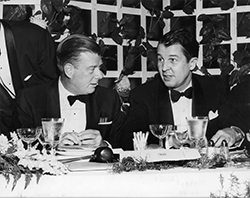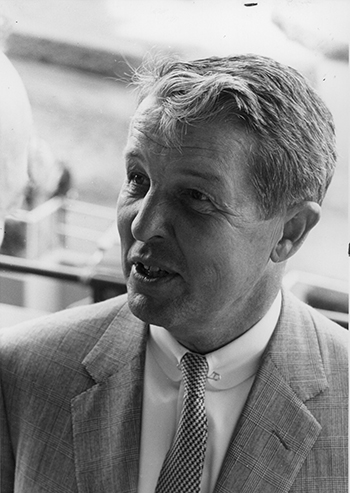Alfred
Vanderbilt enjoyed playing tennis with me. The reason he enjoyed it is that he was
a very bad tennis player, and he sought the company of others of equal ability.
I fit the bill. He liked ladies—in every sense of the word, I'm sure—so it was
usually mixed doubles at Saratoga. Typical of Alfred it suited him to play at
public courts rather than the tonier Saratoga Golf and Polo Club, where very
stylish grass courts were available.
While the
Vanderbilt name is synonymous with heavy brass—stupendous wealth, Alfred never
seemed terribly aware of it. If he was important, he was not absorbed with it. He
was nice enough looking, with a casual, slouchy way about him. His countenance bore
no hint of exuberance, and if he was burning with enthusiasm on some project (and
he often was) you could not tell it. His pedigree was staggering; if he had
been a yearling he would have definitely been a cinch for the select session of
the sale. On the top he was New York Central Railway. On the bottom, Bromo-Seltzer.

Vanderbilt with Arthur Godfrey in 1955
When he
was 21, his mother gave him a nice present: the 600-acre Sagamore Farm (and 50 horses) in the
lovely rolling hills of Maryland. From then on he dedicated his life to horse
racing, and he made a monumental impact on the game. He made no bones about it—he simply adored every aspect of
Thoroughbred racing. He devoted his energy to the farm, the breeding, training,
racing; and also to the running of great racetracks and many of the important
organizations of racing. He never wavered from his dedication to the
sport—repeat sport—of racing horses. He once said, "I have this wonderful
feeling about racing. It's not just that I love horses. I'm like the person who
goes to the circus and falls in love with the whole show, not just the
elephants."
Alfred Vanderbilt in his day was
probably the most respected man in the racing industry of North America.
He bred
and campaigned one of the five greatest horses that ever lived. Native Dancer
was undefeated except for when Eric Guerin got him in a blind switch and lost
the 1953 Kentucky Derby. He also had Discovery, Next Move, Bed O'Roses, Find,
Social Outcast, North Sea and many other slightly lesser lights.
He was
long-time head of NYRA, operating those three race tracks while simultaneously
resuscitating and popularizing semi-moribund Pimlico. His presidency breathed
life into that old place by staging the wonderful War Admiral-Seabiscuit match
race. A controversial but logical move was to remove the picturesque hill in
the middle of the racetrack, so people could see the races. He was the first
racetrack operator to introduce the photo finish camera and the electrically
operated starting gate. All of this, mind you, when he was in his twenties. His
racetrack managerial career was interrupted by World War II, during which Alfred
joined the Navy, captained a PT Boat and was decorated for bravery. After the
war, he resumed his career.
He was a
clever, impish, whimsical, interesting
man, and he attracted such diverse pals as Oscar Levant, George Abbott,
Ernest Hemingway, Hal Prince, Fred Astaire, the Duke of Windsor, and a wide
variety of characters in every walk of life. He was comfortable in his own
skin. For example, he once made an indelible impression on me when I spied him
at a typically frenetic cocktail party in Saratoga. We all know that it is
absolutely essential that at a cocktail party you must never be caught without
someone to talk to. Unthinkable that you would not be screaming at someone! Not
with Alfred. At one point I can see him, with his back to the crush of
revelers, simply standing by himself staring out a window. He would have been
glad to talk but it was not important either way.
One day
in the crowded paddock at Saratoga, he took great pleasure in pointing out to a
friend (the Secretary of the Treasury at the time) that he had a hole in the
seat of his pants. Conceivably this story is apocryphal, but when jockey Ted
Atkinson was about to ride a Vanderbilt long shot in a mile and three-quarter
race, Alfred showed up in the paddock with a sandwich, a flashlight and a
compass, commenting, "It may be dark before you get back."

His
later years literally proved dark for him. A degenerative eye disease made him
close to blind. While he was losing his sight, his son was killed in a
mountaineering accident. And Alfred was discouraged with the way racing was
trending. Still, he kept a few horses, and each morning his driver took him to
the racetrack for training. He stood on the apron and heard—not saw—his horses
go by. He could hardly distinguish a large object. If I passed him I would say,
"Good morning Alfred. It's Cot Campbell." He could then come back with a
greeting.
But late
in the game he got "Derby Fever." He had some horses with trainer Mary Eppler,
and he asked her to go to the sales and buy a colt "that could win the Derby." She
made a good try. She bought a colt and Alfred named him Traitor. He won the
Futurity and was placed in the Champagne. The racing world got excited that a
Vanderbilt horse finally would complete that which Native Dancer sought—and
deserved. Alas, he did not get to the Derby.
Alfred
Vanderbilt—whose birth was announced on the front page of the New York Times in 1912—died in 1999. He passed while dressing for a trip to the racetrack. He was going there to sit
while the races took place.




